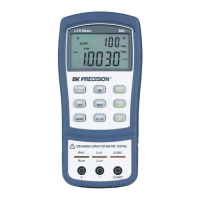26
Figure 8 - Short Calibration
Notes:
1. If test frequency is changed, calibration should be done again before making precision
measurements. Once calibration is done on a selected test frequency, calibration data
will remain until power off.
2. Either open or short calibration is not associated with measurement function, therefore
changing the test function does not require re-calibration.
3. Re-calibration may be necessary depending on many factors such as prolonged use,
changing environments, and contact variation (i.e. alligator test leads or socket
contacts).
Note: To achieve optimal measurement results, both open and short calibration should be done.
It is highly recommended to calibrate extremely high or low values for L, C, R and Z before
making precision measurements.
Primary Parameter (PRI)
The primary display of the LCR meter is used to indicate measured values under four different
modes. These modes are: L (inductance), C (capacitance), R (resistance), and Z (impedance).
To change between these four primary modes of measurement, press the button. The
modes will change and repeat upon each button press. On the screen, the indicators “L”, “C”,
“R”, or “Z”) will be displayed to indicate which mode the meter is in.
NOTE: After changing primary parameter, secondary display indicates the preset frequency. No
secondary parameter display in DCR state. If it is required to display corresponding secondary
parameters, press the secondary button.

